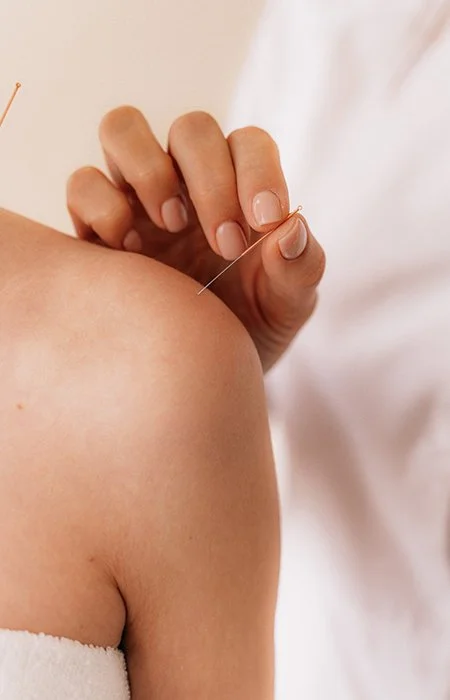Distal points are used in Acupuncture when the area that is in need of treatment is too painful to needle directly, or the point is inaccessible due to the location or patient's ability to move or disrobe. Swelling and inflammation can be so severe in local areas of trauma, that it would do more harm than good to needle in those areas. Conversely, if a patient is unable to move, distal points can be used to reach areas of the body that would otherwise be unable to treat.
Holographic points, points along the meridian that is experiencing the pain, and correspondence points can all be used to treat the pain site without needling the pain site. Holographic points can include, but are not limited to the ear, scalp, face, abdomen, hands or extremeties. These locations are considered microcosms of the body, whereas the entire body can be treated within one of these locations. Locating these points requires palpation. When locating these points, oftentimes the practitioner is looking for the most tender point within the distal area. Tools may be used to pinpoint the exact location of with the most heightened sensitivity. The most frequently used holographic in Acupuncture is the ear. The most common visualization used to explain the microcosm of the ear is an inverted fetus. The head points are located in the lobe of the ear, the spine is located along the antihelix, and the internal organs can be found in the conchae of the ear. Similarly, the scalp can be divided along the centerline.
The centerline is considered the spine, with the cervical area is proximal to the forehead. Scalpacupuncture is particularly useful in treating patients that have suffered a stroke. Dr. Tan and Master Tung are two Acupuncturists that have mastered the use of holographic points and have developed their own techniques in treating a myriad of ailments.
The use of meridians in treatment is a traditional way of using acupuncture, and is as old as the practice itself. Meridian theory is based on the idea the body is connected through a series of channels that traverse through every aspect of the body via the main meridians and their collaterals. There are twelve main meridians that correspond with an organ system, and connect to the eight collaterals. The use of the meridians in treatment with distal points treats pain that is located along the same line as the pain location, on the same side as the pain. For instance, if a person has pain on the dorsal aspect of the foot, along the lateral side (GB 41), the treating physician may choose to use a point such as GB 34 which is located just below the knee on the same channel. If a patient is experiencing pain on the medial aspect of the knee, along the LV or SP meridian, a practitioner may choose to use a point further up the meridian such as SP 10 or LV 9. The practitioner may also choose points further down the meridian like
Sp 5 to treat that same leg pain. This technique can be particularly useful when treating a patient who is unable to lay on the treatment table or disrobe. There are instances where the practitioner is unable to access the pain location. For example, if a patient is wheelchair bound or elderly, and unable to get onto the treatment table. If their extremities are accessable, the practitioner is able to treat hip pain without having to put needles directly into the hip. The meridian theory is common practice in acupuncture, and is a safe and effective way to treat both chronic and acute pain distally.
Correspondent acupuncture points are points that correspond with the location of the body that the practitioner needs to treat. There have been many studies on the use of contralateral acupuncture for the treatment of paralysis. Strokes are a good example of how the contralateral theory works. When a patient experiences a stroke on the right side of the brain, the left side of the body is affected, and vice versa.Sometimes the pain is so great on the side of the patient that has the trauma, the practitioner chooses to use the opposite limb. If a patient has a sprained ankle on the right side for example, there can be severe swelling, inflammation, and bruising at the pain site. The practitioner may then choose to needle the left ankle to treat this patient. The use of corresponding points is extremely useful when treating pain without having to needle into or around the pain. Oftentimes, when patients come for acupuncture treatment after a trauma, they may experience anxiety and fear of the practitioner needling in or around that site. The use of contralateral needling can not only ease the physical pain felt by the patient, but also calm the patient and build trust between patient and practitioner.





